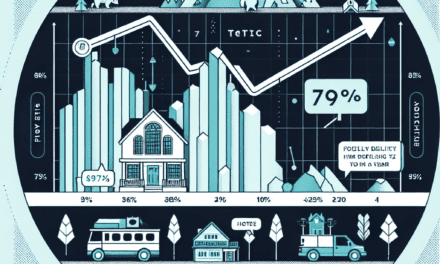“German Debt Woes: Catalyzing a New Era in Global Markets”
Introduction
In recent months, Germany has found itself at the center of a significant financial upheaval, as mounting debt concerns have triggered a historic shift in market dynamics. Traditionally viewed as the economic powerhouse of Europe, Germany’s fiscal stability has long been a cornerstone of investor confidence. However, a confluence of factors, including increased public spending, economic slowdowns, and external pressures, has raised alarms about the sustainability of its debt levels. This unprecedented situation has led to a reevaluation of risk assessments and investment strategies, not only within Germany but across global markets. As investors grapple with the implications of these developments, the ripple effects are being felt in bond yields, currency valuations, and stock market performances, marking a pivotal moment in the financial landscape.
Impact Of German Debt Concerns On European Markets
The recent concerns surrounding German debt have sent ripples through European markets, marking a historic shift that has captured the attention of investors and policymakers alike. As Europe’s largest economy, Germany has long been considered a pillar of financial stability within the European Union. However, the emergence of debt-related anxieties has prompted a reevaluation of this perception, leading to significant market reactions across the continent. This development is not only reshaping investor sentiment but also influencing broader economic strategies within the EU.
To understand the impact of these concerns, it is essential to consider the context in which they have arisen. Germany’s economic model, characterized by fiscal prudence and a strong export sector, has traditionally shielded it from the volatility experienced by other European nations. Nevertheless, recent global economic challenges, including supply chain disruptions and energy price fluctuations, have placed unprecedented pressure on the German economy. Consequently, the country’s debt levels have come under scrutiny, raising questions about its ability to maintain fiscal discipline in the face of mounting economic pressures.
As these concerns have gained traction, European markets have responded with heightened volatility. Investors, who once viewed German bonds as a safe haven, are now reassessing their portfolios in light of the perceived risks. This shift in sentiment has led to fluctuations in bond yields, with German bunds experiencing increased selling pressure. The ripple effects of this market behavior are being felt across the eurozone, as other member states grapple with the implications of a potentially less stable German economy.
Moreover, the impact of German debt concerns extends beyond the bond market. Equity markets across Europe have also been affected, as investors weigh the potential consequences for corporate earnings and economic growth. Companies with significant exposure to the German market are facing increased scrutiny, as analysts attempt to gauge the potential fallout from a prolonged period of economic uncertainty. This has resulted in a more cautious approach to investment, with market participants seeking to mitigate risk in an environment characterized by heightened unpredictability.
In addition to influencing investor behavior, the situation has prompted a reevaluation of economic policy within the European Union. Policymakers are now tasked with balancing the need for fiscal responsibility with the imperative to support growth in a challenging economic landscape. This delicate balancing act is further complicated by the interconnected nature of the European economy, where the fortunes of one nation can have far-reaching implications for its neighbors. As such, the German debt concerns have sparked discussions about the need for greater fiscal coordination and solidarity within the EU, as member states seek to navigate this period of uncertainty together.
In conclusion, the concerns surrounding German debt have triggered a historic market shift that is reshaping the European financial landscape. As investors and policymakers grapple with the implications of this development, the focus is increasingly on finding a path forward that ensures stability and growth for the region as a whole. While the challenges are significant, they also present an opportunity for Europe to strengthen its economic foundations and enhance its resilience in the face of future uncertainties. As the situation continues to evolve, the eyes of the world remain fixed on Germany and its role in shaping the future of the European economy.
Historical Context Of Germany’s Debt Crisis
The recent concerns surrounding Germany’s debt have triggered a historic shift in the financial markets, drawing attention to the historical context of the nation’s fiscal policies and economic strategies. To understand the current situation, it is essential to delve into Germany’s economic history, which has been characterized by a strong commitment to fiscal discipline and a cautious approach to debt accumulation. This commitment has its roots in the post-World War II era, when Germany, then West Germany, embarked on a path of economic recovery and growth, guided by the principles of the social market economy. The Wirtschaftswunder, or economic miracle, of the 1950s and 1960s was underpinned by sound fiscal policies that prioritized balanced budgets and low inflation.
As the decades progressed, Germany’s economic landscape evolved, yet the emphasis on fiscal prudence remained a constant. The reunification of East and West Germany in 1990 posed significant economic challenges, as the integration of the two economies required substantial public investment. Despite these challenges, Germany managed to maintain a relatively low level of public debt compared to other major economies, thanks in part to its robust industrial base and export-oriented economy. The introduction of the euro in 1999 further solidified Germany’s role as a key player in the European and global economies, with the country often serving as a benchmark for fiscal responsibility within the Eurozone.
However, the global financial crisis of 2008 and the subsequent European sovereign debt crisis tested Germany’s fiscal resilience. While many European countries struggled with soaring debt levels and economic instability, Germany emerged relatively unscathed, largely due to its strong fiscal position and the implementation of austerity measures. These measures, though controversial, reinforced Germany’s reputation as a bastion of fiscal discipline. Nevertheless, the crisis also highlighted the interconnectedness of European economies and the potential risks posed by high levels of public debt.
In recent years, Germany’s debt concerns have resurfaced, driven by a combination of domestic and international factors. The COVID-19 pandemic necessitated unprecedented levels of government spending to support businesses and individuals, leading to a significant increase in public debt. Additionally, geopolitical tensions and supply chain disruptions have added to the economic uncertainty, prompting questions about the sustainability of Germany’s fiscal policies. As a result, financial markets have reacted with heightened volatility, reflecting investor apprehension about the future trajectory of Germany’s debt.
This historic market shift underscores the importance of understanding the broader historical context of Germany’s debt crisis. While the country’s commitment to fiscal discipline has served it well in the past, the current challenges require a nuanced approach that balances the need for economic stability with the demands of a rapidly changing global landscape. As policymakers grapple with these complex issues, the lessons of history offer valuable insights into the potential paths forward. By drawing on its rich economic heritage and adapting to new realities, Germany can navigate its debt concerns and continue to play a pivotal role in shaping the future of the European and global economies.
In conclusion, the historical context of Germany’s debt crisis provides a crucial framework for understanding the current market dynamics. As the nation confronts new economic challenges, its legacy of fiscal prudence and adaptability will be key to ensuring long-term stability and prosperity. Through careful analysis and strategic decision-making, Germany can address its debt concerns while maintaining its position as a leader in the global economic arena.
Investor Reactions To Germany’s Financial Instability
The recent concerns over Germany’s financial stability have sent ripples through global markets, triggering a historic shift in investor behavior. As Europe’s largest economy, Germany has long been considered a bastion of fiscal prudence and economic stability. However, recent developments have cast a shadow over this reputation, prompting investors to reassess their strategies and portfolios. The root of these concerns lies in Germany’s rising debt levels, which have been exacerbated by a combination of factors, including increased government spending, economic challenges, and external pressures.
In recent years, Germany has faced mounting fiscal pressures, leading to a significant increase in public debt. The COVID-19 pandemic necessitated substantial government intervention to support businesses and individuals, resulting in unprecedented levels of borrowing. While these measures were crucial in mitigating the immediate economic impact, they have left Germany with a debt burden that is raising eyebrows among investors. Furthermore, the ongoing energy crisis, driven by geopolitical tensions and supply chain disruptions, has added to the fiscal strain, necessitating further government spending to stabilize the economy.
As a result, investors are increasingly concerned about Germany’s ability to manage its debt sustainably. Traditionally, German government bonds, known as Bunds, have been viewed as a safe haven for investors seeking stability and low risk. However, the current financial landscape has led to a reevaluation of this perception. Investors are now questioning whether Germany can maintain its fiscal discipline and continue to offer the security that Bunds have historically provided. This uncertainty has led to a shift in investor sentiment, with many seeking alternative investment opportunities that offer better returns or lower perceived risks.
In response to these concerns, there has been a noticeable shift in capital flows. Investors are diversifying their portfolios, moving away from German assets and exploring opportunities in other markets. This trend is evident in the increased demand for U.S. Treasury bonds, which are perceived as a more stable alternative in the current climate. Additionally, emerging markets are attracting attention as investors seek higher yields and growth potential. This reallocation of capital is reshaping the global investment landscape, with significant implications for both developed and developing economies.
Moreover, the shift in investor sentiment is not limited to fixed-income markets. Equity markets are also experiencing volatility as investors reassess their exposure to German companies. Concerns about the potential impact of rising debt levels on corporate profitability and economic growth are prompting investors to adopt a more cautious approach. This has led to increased market volatility, with stock prices fluctuating in response to changing perceptions of risk and opportunity.
In conclusion, the concerns over Germany’s financial stability have triggered a historic shift in investor behavior, with significant implications for global markets. As investors navigate this new landscape, they are reassessing their strategies and seeking opportunities that align with their risk tolerance and return expectations. While Germany’s economic fundamentals remain strong, the current challenges underscore the importance of fiscal discipline and prudent economic management. As the situation continues to evolve, investors will be closely monitoring developments, ready to adapt their strategies in response to changing market conditions. This period of uncertainty serves as a reminder of the interconnectedness of global markets and the need for vigilance in an ever-changing economic environment.
Long-term Implications Of Germany’s Debt Issues
The recent concerns surrounding Germany’s debt have triggered a historic shift in the financial markets, raising questions about the long-term implications for both the German economy and the broader European Union. As Europe’s largest economy, Germany has long been considered a pillar of financial stability, often serving as a benchmark for fiscal responsibility. However, the recent surge in debt levels has prompted investors and policymakers to reassess their expectations, leading to significant market volatility and uncertainty.
To understand the potential long-term implications, it is essential to first examine the factors contributing to Germany’s rising debt. The COVID-19 pandemic played a pivotal role, as the German government implemented expansive fiscal measures to support businesses and individuals during the crisis. These measures, while necessary to mitigate the immediate economic impact, resulted in a substantial increase in public debt. Additionally, the ongoing energy transition and the need for substantial investment in infrastructure and technology have further strained public finances.
As a result, investors have begun to question Germany’s ability to maintain its historically low borrowing costs. This shift in sentiment has led to an increase in bond yields, reflecting the perceived risk associated with German debt. The rise in yields is not only a concern for Germany but also for the broader Eurozone, as it could lead to higher borrowing costs for other member states. Consequently, this development has sparked discussions about the sustainability of the European Central Bank’s monetary policy, which has been characterized by low interest rates and quantitative easing.
Moreover, the implications of Germany’s debt issues extend beyond financial markets. The country’s fiscal challenges could have significant political ramifications, both domestically and within the European Union. Domestically, the government may face increased pressure to implement austerity measures or tax reforms to address the growing debt burden. Such measures could prove unpopular with the electorate, potentially leading to political instability. Within the EU, Germany’s debt concerns could strain relations with other member states, particularly those with weaker economies that rely on German support.
Furthermore, the shift in market dynamics could have broader economic consequences. Higher borrowing costs may dampen investment and economic growth, both in Germany and across the Eurozone. This could hinder the region’s recovery from the pandemic and exacerbate existing economic disparities between member states. Additionally, the increased focus on debt sustainability may divert attention from other pressing issues, such as climate change and digital transformation, which require significant investment and international cooperation.
In light of these challenges, it is crucial for Germany and its European partners to adopt a balanced approach that addresses both short-term fiscal pressures and long-term economic objectives. This may involve a combination of targeted fiscal measures, structural reforms, and enhanced cooperation at the EU level. By doing so, Germany can work towards restoring investor confidence and ensuring the stability of the Eurozone.
In conclusion, the historic market shift triggered by German debt concerns underscores the need for careful consideration of the long-term implications for both the German economy and the broader European Union. As policymakers navigate this complex landscape, they must strike a delicate balance between fiscal responsibility and economic growth, while also addressing the broader challenges facing the region. Through prudent policy decisions and enhanced cooperation, Germany and its European partners can work towards a more stable and prosperous future.
Comparative Analysis: Germany’s Debt Vs. Other EU Nations
In recent months, the financial landscape of Europe has been significantly impacted by growing concerns over Germany’s national debt, prompting a historic shift in market dynamics. Traditionally viewed as the economic powerhouse of the European Union, Germany’s fiscal policies and economic stability have long served as a benchmark for other EU nations. However, the recent surge in its national debt has raised eyebrows, leading to a comparative analysis of Germany’s debt situation relative to other EU countries.
Germany’s debt-to-GDP ratio, a critical indicator of economic health, has been on an upward trajectory, sparking debates among economists and policymakers. This shift is particularly noteworthy given Germany’s historical commitment to fiscal prudence and balanced budgets. The increase in debt can be attributed to several factors, including the economic fallout from the COVID-19 pandemic, increased public spending to stimulate growth, and investments in green energy and digital infrastructure. As Germany grapples with these challenges, the implications for the broader EU economy are profound.
In contrast, other EU nations have experienced varying degrees of success in managing their national debts. For instance, countries like France and Italy have historically struggled with higher debt levels, often exceeding the EU’s recommended threshold of 60% of GDP. Despite these challenges, recent efforts to implement fiscal reforms and stimulate economic growth have shown promise, albeit with mixed results. Meanwhile, smaller economies such as the Netherlands and Finland have maintained relatively low debt levels, benefiting from robust economic policies and prudent fiscal management.
The divergence in debt management strategies among EU nations highlights the complexity of achieving economic stability within a union of diverse economies. While Germany’s rising debt levels have raised concerns, it is essential to consider the broader context of its economic strength and resilience. Germany’s robust industrial base, strong export sector, and low unemployment rate provide a buffer against potential economic shocks, allowing it to manage its debt more effectively than some of its EU counterparts.
Moreover, the European Central Bank’s monetary policies play a crucial role in shaping the debt landscape across the EU. With interest rates remaining at historically low levels, countries have been able to borrow at reduced costs, providing an opportunity to invest in growth-oriented initiatives. However, this environment also poses risks, as any future increase in interest rates could exacerbate debt servicing challenges for heavily indebted nations.
As Germany navigates its debt concerns, the implications for the EU are multifaceted. On one hand, Germany’s economic stability is vital for the overall health of the EU, given its role as a key driver of growth and integration. On the other hand, the need for coordinated fiscal policies and mutual support among EU nations has never been more critical. The recent market shift underscores the importance of collaboration and solidarity in addressing shared economic challenges.
In conclusion, Germany’s rising debt levels have triggered a historic market shift, prompting a reevaluation of fiscal policies across the EU. While Germany’s situation is concerning, it also serves as a reminder of the interconnectedness of EU economies and the need for collective action. As the EU continues to navigate these challenges, the lessons learned from Germany’s experience will undoubtedly inform future policy decisions, shaping the economic landscape of Europe for years to come.
Policy Responses To Germany’s Debt Concerns
The recent escalation of Germany’s debt concerns has prompted a significant shift in market dynamics, compelling policymakers to devise strategic responses aimed at stabilizing the economic landscape. As Europe’s largest economy, Germany’s fiscal health is pivotal not only to its own prosperity but also to the broader European Union. Consequently, the German government’s approach to addressing these debt concerns is being closely scrutinized by both domestic and international stakeholders. In response to the mounting debt levels, German policymakers have embarked on a multifaceted strategy that seeks to balance fiscal responsibility with economic growth.
Initially, the German government has prioritized fiscal consolidation as a cornerstone of its policy response. This involves a commitment to reducing the budget deficit through a combination of expenditure cuts and revenue-enhancing measures. By implementing austerity measures, the government aims to reassure investors and credit rating agencies of its commitment to maintaining fiscal discipline. However, this approach is not without its critics, who argue that excessive austerity could stifle economic growth and exacerbate social inequalities. To mitigate these concerns, the government is also exploring targeted investments in key sectors such as infrastructure, technology, and renewable energy, which are expected to stimulate economic activity and create jobs.
In addition to domestic measures, Germany is actively engaging with its European partners to address the broader implications of its debt situation. Recognizing the interconnectedness of the European economies, German policymakers are advocating for enhanced fiscal coordination and integration within the Eurozone. This includes proposals for a common fiscal policy framework and the establishment of a European Monetary Fund to provide financial assistance to member states in distress. By fostering greater economic cohesion, Germany aims to bolster the resilience of the Eurozone against future financial shocks.
Moreover, the German government is leveraging its influence within international financial institutions to advocate for reforms that promote global financial stability. This includes calls for stricter regulation of financial markets and enhanced transparency in sovereign debt reporting. By championing these reforms, Germany seeks to address systemic vulnerabilities that could exacerbate its own debt challenges and those of other nations.
As part of its comprehensive policy response, Germany is also focusing on structural reforms aimed at enhancing the competitiveness of its economy. This involves measures to improve labor market flexibility, increase productivity, and foster innovation. By creating a more dynamic economic environment, Germany hopes to generate sustainable growth that will facilitate debt reduction over the long term. Furthermore, these reforms are intended to position Germany as a leader in the transition to a digital and green economy, thereby ensuring its economic relevance in the face of global challenges such as climate change and technological disruption.
In conclusion, Germany’s debt concerns have triggered a historic market shift that necessitates a robust and multifaceted policy response. By balancing fiscal consolidation with strategic investments, advocating for greater European integration, and championing global financial reforms, Germany is striving to navigate its debt challenges while safeguarding its economic future. As these policy measures unfold, their effectiveness will be closely monitored by market participants and policymakers alike, with the hope that they will restore confidence and stability to both the German and European economies.
The Role Of The ECB In Addressing German Debt Challenges
The recent concerns surrounding German debt have triggered a historic shift in the financial markets, prompting a closer examination of the European Central Bank’s (ECB) role in addressing these challenges. As Europe’s largest economy, Germany has long been considered a pillar of financial stability within the Eurozone. However, the evolving economic landscape, exacerbated by global uncertainties and domestic fiscal pressures, has led to increased scrutiny of Germany’s debt levels. In this context, the ECB’s policies and interventions are pivotal in managing the potential repercussions on both national and regional scales.
To understand the ECB’s role, it is essential to first consider the underlying factors contributing to Germany’s debt concerns. The COVID-19 pandemic, for instance, necessitated substantial fiscal stimulus measures, leading to increased government borrowing. Additionally, the energy crisis, partly driven by geopolitical tensions, has further strained public finances. These developments have raised questions about the sustainability of Germany’s debt, traditionally viewed as conservative and manageable. Consequently, the ECB’s monetary policy decisions have become increasingly significant in shaping market perceptions and responses.
The ECB, as the central bank for the Eurozone, is tasked with maintaining price stability and supporting economic growth. In light of German debt concerns, the ECB’s approach to interest rates and asset purchases is crucial. By keeping interest rates low, the ECB aims to reduce borrowing costs for governments, including Germany, thereby alleviating some of the immediate fiscal pressures. Moreover, through its asset purchase programs, the ECB provides liquidity to the markets, ensuring that governments can finance their debt at sustainable rates. These measures are designed to instill confidence among investors and prevent a potential escalation of financial instability.
However, the ECB’s interventions are not without challenges. Balancing the need for economic support with the risk of inflation is a delicate task. As inflationary pressures mount, partly due to supply chain disruptions and energy price hikes, the ECB faces the dilemma of whether to tighten monetary policy. A premature increase in interest rates could exacerbate debt servicing costs for Germany and other Eurozone countries, potentially stifling economic recovery. Conversely, maintaining an accommodative stance for too long might fuel inflation, eroding purchasing power and savings.
In addressing German debt challenges, the ECB also collaborates with national governments and other European institutions. The coordination of fiscal and monetary policies is vital to ensure a cohesive response to the debt situation. The ECB’s role extends beyond monetary policy; it involves facilitating dialogue and cooperation among member states to implement structural reforms that enhance economic resilience. By promoting fiscal discipline and encouraging investment in sustainable growth sectors, the ECB contributes to a more robust economic framework that can withstand future shocks.
In conclusion, the ECB plays a critical role in addressing the challenges posed by German debt concerns. Through its monetary policy tools and collaborative efforts with national governments, the ECB seeks to maintain financial stability and support economic recovery. As the situation evolves, the ECB’s ability to adapt its strategies will be crucial in navigating the complex interplay of fiscal pressures and market dynamics. Ultimately, the ECB’s actions will not only influence Germany’s economic trajectory but also shape the broader Eurozone’s path towards sustainable growth and stability.
Q&A
1. **What triggered the historic market shift in Germany?**
Concerns over rising German debt levels and fiscal policies triggered the market shift.
2. **How did the bond market react to German debt concerns?**
Yields on German government bonds increased as investors demanded higher returns for perceived risks.
3. **What impact did the debt concerns have on the Euro?**
The Euro experienced volatility and potential depreciation against other major currencies.
4. **How did German equities respond to the debt concerns?**
German stock markets faced increased volatility and potential declines as investor confidence wavered.
5. **What measures did the German government consider to address debt concerns?**
The government considered implementing austerity measures and fiscal reforms to stabilize debt levels.
6. **How did international markets react to Germany’s debt situation?**
International markets showed increased caution, with potential ripple effects on European and global markets.
7. **What long-term implications could arise from Germany’s debt concerns?**
Long-term implications might include changes in fiscal policy, potential impacts on the European Union’s economic stability, and shifts in investor confidence.
Conclusion
The recent concerns over German debt have triggered a historic shift in financial markets, reflecting broader anxieties about fiscal stability in Europe’s largest economy. As investors reassess the risk associated with German bonds, traditionally seen as a safe haven, there has been a notable reallocation of capital towards other assets. This shift has led to increased volatility in bond yields and has prompted a reevaluation of investment strategies globally. The situation underscores the interconnectedness of global markets and the potential for domestic fiscal issues to have far-reaching implications. In conclusion, the German debt concerns highlight the need for vigilant fiscal management and the importance of maintaining investor confidence to ensure economic stability.





